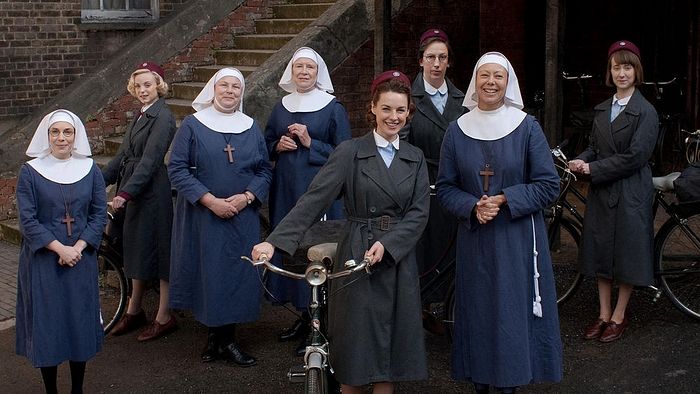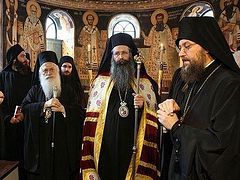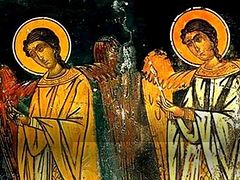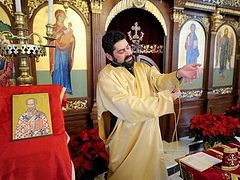I am a great fan of the BBC series “Call the Midwife”, which features a group of Anglican sisters working among the poor in a London neighbourhood as midwives. Their order is fictional, but is based upon the actual order and London experiences of the Community of St. John the Divine, then working in London and now moved to Birmingham. Being such a fan of the series, I wanted to check out the real community online. Their numbers are fewer now, as the community has been reduced to five elderly women. What interested me was that unlike their BBC counterparts who wore a blue monastic habit, veil and wimple, the sisters today no longer wear a monastic habit, having dispensed with it since the days when they wore it in the 1960s. In this they are no different than other western monastic orders of nuns, including many Roman Catholic nuns, who since the days of Vatican II have also put aside their monastic habits and adopted secular dress.
It reminded me of a similar phenomenon among the parish clergy. It used to be that a parish priest could be as readily identified on the street by his outward dress, just as monastics could be identified by theirs, at least in the Roman Catholic, Anglican, and Orthodox traditions. Anglican clergy wore a black suit, and a white collar (popularly called “a dog collar”), as did Roman Catholic clergy. Since the days of Vatican II, western clergy have begun dispensing with black suit and collar, and now cannot always be readily identified as clergy when on the street or not officiating at the altar. In some Anglican circles, this outward shedding of clerical dress has been also accompanied by a shedding the clerical title: the clergyman is no longer “Rev. Smith” or “Father Smith”. Now he says, “Just call me Bob.” An exception is that of women clergy—a priestess, in my experience, can usually be counted on to sport the clerical shirt and collar, thereby stressing her clerical status. I remember in particular one photo of a group of Anglican clergy: the male bishop and the male priests in the group photo all wore sport shirts and turtlenecks. The one female priest in the group wore a prominent clerical collar. As she doubtless intended, there was no mistaking her for a layperson.
So, what’s the deal with clerical dress and monastic habits? Do they really matter? Obviously there are things more important than the clothes on one’s back, and no one suggests that one cannot be holy without clerical dress or that outer clerical dress automatically bestows inner sanctity. But I suggest that even so, such things do matter. The proof that they matter is that some have dispensed with them. No one who says of something, “It doesn’t matter, so we should get rid of it” is really quite honest. If it really didn’t matter, then one wouldn’t be concerned about it one way or the other. Clearly the thing has some significance; it is that significance that the reformers are concerned to deny and ditch. When a Baptist says to me, “Incense doesn’t matter, so why use it?”, and when I reply, “If it really doesn’t matter, then let’s keep it”, it then becomes apparent that to him it matters a great deal, which is why he wants to get rid of it. So then we may ask: what is the significance of monastic habit and clerical dress?
It is not just that such habits and cassocks are hot to wear and can be uncomfortable in warm weather. That is true, but it is also true for the wearing of Eucharistic vestments in August, and no one suggests that we ditch them during the Eucharist in the summer in favour of an open neck sports shirt. If the sole perceived problem was merely that the clothes were too warm in summer, one would find the answer in lighter fabrics. Obviously the perceived problem lies elsewhere.
Those monastics arguing in defense of secular dress (such as Sr. Marilyn Baker, a humble and sincere nun of the Sisters of Providence) themselves state where they think the problem lies, and why they dispensed with their monastic habit. They report that they were “advised to become more part of the modern world”, and so they complied by dispensing with their habits. That is, the shedding of the habit was part and parcel of the drive toward secularization, closing the distance between the Church and secular society. For obviously nuns such as the Sisters of Providence were already geographically “part of the modern world” by virtue of them not living a completely enclosed life shut off from everyone else. They did not live as cloistered hermits, but lived and worked among others in society—rather like the nuns featured on “Call the Midwife”. They just wore their habits while working as part of the modern world as a sign and pointer to another power beyond that of merely secular society. The directive to become more part of the modern world therefore referred to ideology, not geography.
This is why the shedding of the habit (or, for Orthodox clergy, the cassock) is a mistake. It is true that the monastic or the clergyman knows who they are, and do not need the clothing to tell them that. But they do not wear that clothing in public for themselves, but for others. If it really is too warm to wear while weeding the garden, it can be dispensed with privately while doing the weeding. The different form of dress worn in public witnesses to the presence of the Church in society, and confirms that the Church is compassionately active in the modern world.
More than that, such clothing witnesses and manifests historical continuity. A habit is not just a bit of clothing, but a uniform, a link, one that stretches through space and time. It unites the wearer to all those others who wear the same uniform, bonding them together visibly as one single reality, wherever those others may live in other parts of the world. It also (and perhaps more importantly) unites the wearer to all those who have worn it in centuries past. A person in today’s society sees a monastic habit and does simply think, “here is a monastic”, but also “here is the presence of centuries of liturgical practice, and history, and tradition, and dogma”. It is this last that I suspect is the sticking point for those advising people like Sr. Marilyn to “become more part of the modern world”. In advising this they were not asking her to mix with the people around her more than she already was, but to close the ideological gap separating the Church and the World. The true target of those advising ditching the habit was the dogma and tradition it represented, not the warm yards of cloth themselves.
This is perhaps why, anecdotal evidence suggests, the western monastic orders which have dispensed with the habit are declining, while those which have retained it are growing. For secular people may applaud the church when it becomes secular and more like “part of the modern world”. But they will not join that church. Pro-choice people, for example, will be happy if the church adopts a pro-choice stance, but they will not get up out of bed and troop to that pro-choice church for liturgy on Sunday. Rather, they will roll over and sleep in, or else go jogging on Sunday morning, like all the other secular people. One joins a church or a monastic community precisely because it is in some way unlike the modern world, and presents one with a clear alternative to secularism. The different clothing witnesses to the presence of this clear alternative—one rooted in the past centuries and preserving its liturgical practice, history, tradition, and dogma. Wearing a cassock will not save the wearer, or even necessarily indicate that the wearer is spiritually healthy. As Christ warned us, Pharisees also like long robes (Luke 20:46). But a church intent on ditching the cassock to become more part of the modern world is church preparing to die.





I am not Catholic! And what is Catholic liberalism???
And who compared a skirt to tight pants??
My comments were discursive rather than polemic.
On the subject of dress I find it very strange that in the Orthodox church a woman is expected to wear a dress or skirt and that a pair of loose trousers with long tunic are not acceptable (although such an outfit is far more modest than any skirt with a pair of legs poking out the bottom (regardless of whether it is mini, knee length, or midi)). No Pakistani, Baloch, or Kurd women would be welcome in an Orthodox church in their customary dress. I know the OT scripture which is often quoted on this topic regarding "women in men's clothing" - but men customarily wore robes / short tunics; not trousers at that time. This OT scripture was directed at deliberate impersonation, and deceit / highly unsavoury intents and practices; not fashion.
If as a priest I were to say that my secular identity is as important as my religious and spiritual one, my way of thinking should be called into question.
On the other hand, if I were to wear my cassock on a trip to the supermarket with my family, it would be fair to ask why. If every waking moment of the day I have to be seen as a priest and never as a father and husband out with the family, this could become a sort of clerical barrier to meeting others on any common level.
In other words I may be seen as standing on my position as priest and insisting too much that I am different. It's the 'too much' part that is the point. This needs discernment and can be a real temptation.
Greetings from Medway, Massachusetts USA.
Dom Theodore,
Prior
Monastery of Our Lady and Saint Laurence
Antiochian Orthodox Western Rite Vicariate